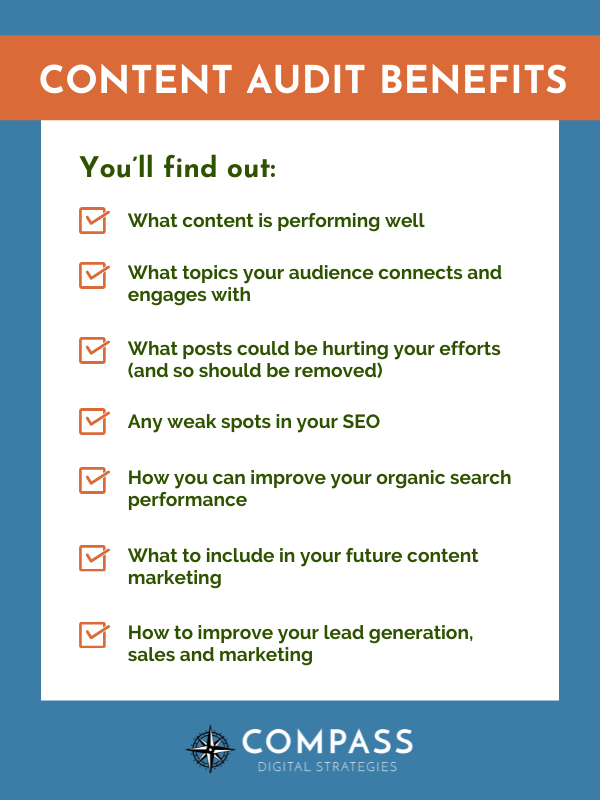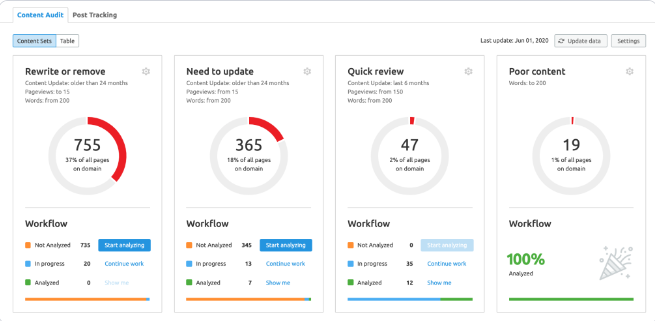Conducting a Content Audit in 2024: 4 Steps to Follow
Do you want to use your content marketing to its fullest potential? It’s important to conduct a regular audit of your existing content, as well as any new content you create. Auditing your old content is where the key to success lies.
Without going back and re-evaluating your content through a comprehensive content audit process, you’re missing out on an opportunity to improve it.
You can add new features and make changes that will help your audience engage with your content and drive results for your business.
What is a Content Audit?
A content audit is a comprehensive analysis of all the content on your website, evaluating each piece’s performance, relevance, and alignment with your overall content strategy. The audit process typically involves a thorough examination of landing pages, web pages, blog posts, and other forms of existing content. By reviewing factors like SEO performance, content quality, word count, and internal links, you can determine whether your content is properly optimized for search engines and target audience engagement.
During a site audit, you collect content audit data and organize it into a content audit spreadsheet or use a content audit tool. This allows you to track the performance of each page, identify underperforming content, and pinpoint outdated content that may be negatively affecting your search engine visibility. The end goal is to create a more cohesive, up-to-date, and SEO optimized website that supports your business goals and enhances your content marketing efforts.
What is the Purpose of a Content Audit?
The primary purpose of a content audit is to evaluate your website content to ensure it aligns with your content marketing strategy and business objectives. A broad content audit helps you identify gaps, remove irrelevant or outdated content, and optimize high-value multiple pages to improve your site’s SEO performance. This process ultimately enhances your site’s search engine visibility and drives more organic traffic.
Through the content audit process, you can also assess the effectiveness of your meta descriptions, page title, and on-page SEO elements, ensuring that each piece of content is properly optimized for keyword rankings. Moreover, a content audit helps you understand how many backlinks and internal links each page has, allowing you to implement link optimization strategies that further improve your search rankings.
By performing a content audit, you can focus on your main focus keywords, improve the performance of underperforming content, and ensure that your site content remains up to date and relevant to your target audience. The insights gained from a content audit are crucial for refining your content strategy and ensuring that your content marketing efforts are effective.
Benefits of Content Audits
Content audits are an important part of any digital strategy, and they are essential for companies with large amounts of online content.
Content audits help you find which aspects of your company’s digital presence are working well and what is lacking. They provide insight into how your audience is interacting.
You can then use this knowledge to better promote or update the areas that need work.
Conducting a content audit is a fantastic way for your business to measure its success and identify growth opportunities.

Content auditing tools such as Google Analytics, Screaming Frog, SEMrush, and more help you find problem areas on your site by analyzing data from search engines, social media sites and other platforms where you publish content.
By going back through your old content, you’ll be able to identify what types of information people are looking for. You can discover how they find it and how they interact with it.
You’ll also be able to determine what type of tone works best for different types of audiences and find ways to optimize the information to appeal more directly to them.
Four Essential Steps on How to Audit Your Content: A Content Audit Process
1. Identify Company Goals
To conduct a successful content audit, you need to identify your company goals and how your current content aligns with your content strategy.
Improved SEO results? Increased audience engagement? Improved conversion rate?
Once you know what you want from your business, it will be easier to figure out what kind of content is needed.
If you want to identify which topics are popular and create more similar content, you should analyze user behaviour and engagement metrics.
If you want to focus on your SEO performance, check the number of backlinks and analyze your rankings in search engines.
2. Map Out All Your Content
Start by mapping out all of your content on an organizational chart.
This will give you an idea of what needs to be reworked and which parts should be kept.
Then, you’ll want to prioritize the items that need work by using a content audit tool (if you want to make it easier on yourself).
Which content are you going to audit?
You can audit the content for product descriptions, blog posts, publications, etc.
To accomplish this, you need to categorize them based on their type, format, number of words or other and collect the URLs of your chosen web pages.
If you have a small website, do this manually and put them in a content audit spreadsheet.

3. Analyze Your Data
Content analytics is the measurement of the state of your content.
This includes things like how many people have viewed your content, how many interactions it has had (comments and likes), and what your engagement rate is.
A content audit template is a crucial tool for evaluating existing content’s effectiveness in driving business results. It helps in organizing content inventories, optimizing on-page SEO, and tracking necessary improvements during the audit process.
There are many different ways you can do this, depending on what you want to measure and how deep you want to go into analysis.
When analyzing, here are some things to take note of:
Is there any content that’s missing?
Which content could be getting the numbers you want?
What is your audience interested in that you haven’t covered yet?
Can you update and optimize the old content, or do you need to remove it?
Which pieces of content are performing extremely well?
Adjust Your Content Marketing Strategy with New Findings From Your Audit to Improve SEO Performance
Use your collected data to try to assess each piece of content according to your goals, and then divide it into what needs to be done, what you should do more of, and what is no longer needed.
Create an editorial calendar that accounts for these changes and ensures you post on all channels and at the right times of day for each audience segment.
Update your analytics tags on all posts to track how the new content is performing against the old content. This way you can adjust accordingly in the future.
Internal links are crucial for enhancing website traffic and page rankings. Identify and implement internal links effectively to optimize search performance.
Rewrite or remove old articles published more than 2 years ago (those that are underperforming.)
Optimize old pages that are getting some traffic to boost their website rankings.
Think about how you can improve new pages that are getting some traffic, too, lately.
Top Content Audit Tools for Effective Auditing
Conducting a content audit can be a complex task, but using the right content audit tools can simplify the process and provide valuable insights. Here are some of the top tools you can use for an effective content audit:
Google Analytics: A powerful tool that provides in-depth data about your site’s performance, including page views, bounce rates, and organic traffic. It helps you evaluate how well your content is performing and identify underperforming pages.
Google Search Console: Offers insights into how your web pages are performing in search results. It helps you track keyword rankings, identify broken links, and monitor site audit issues.
Screaming Frog: A site audit tool that crawls your website and provides detailed information about meta descriptions, page titles, internal links, and more. It’s an essential tool for identifying outdated content and ensuring that your content is properly optimized.
SEMrush Content Audit Tool: Allows you to perform a comprehensive content audit by analyzing the performance of your website pages. It provides insights into content quality, focus keywords, word count, and more, helping you optimize your entire website.
Ahrefs Content Audit: This tool helps you perform a thorough content audit by analyzing content audit data such as search engine rankings, backlinks, and outbound links. It helps you identify underperforming content and implement strategies to improve SEO performance.
Using these tools, you can perform a successful content audit that not only improves your website content but also enhances your overall content marketing strategy.
With the right content audit templates and tools, you can ensure that your content up to date, relevant, and optimized for both your target audience and search engines.
Conclusion
The goal of this blog post was to guide you through the process of conducting a content audit for your website.
This can be beneficial for anyone considering how to do a content audit, what is a content audit, or how you know if you need one.
I hope you have gained valuable information on this topic and feel confident about conducting your own website audit.





